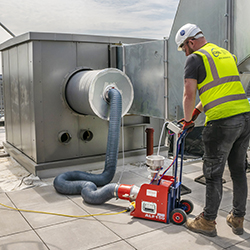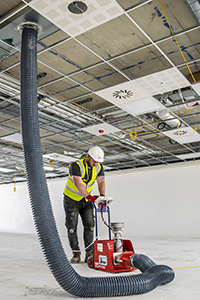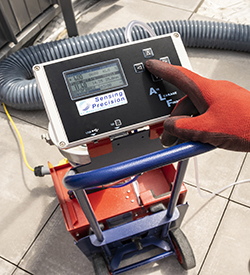Feel the pressure

Building regulations specify that sheet metal ductwork leakage testing “should be carried out in accordance with the procedures set out in B&ES DW/144” for new buildings (ADL2A) and for existing buildings (ADL2B).
Leakage from ductwork will affect the overall efficiency of the building services. It will undermine the BMS in terms of air movement measurement and also the ability of the system to effectively control the environment, providing a less than optimum heating or cooling to the building occupants and impacting upon energy costs.
It is possible to predict the likely leakage from ductwork during design. As leakage occurs at the seams and joints, it is proportional to the total surface area of the ductwork, taking into consideration of the configuration of the system and the building it serves. This can be compared to actual leakage seen when tested. A key variable here will be air pressure – although there is no precise formula for calculating this, a key guide is that leaks will increase in proportion to pressure to the power of 0.65. Other key variables here will be the quality of the design, the workmanship in the installation of the ductwork and the quality of the ductwork itself.
 |
| Pressure testing of ductwork should be considered a vital part of the commissioning process |
Operating pressures
The integrity of the installed ductwork relies upon its manufacture, and that depends upon the proper application of the correct sealant, gaskets or tape, and suitability for operating temperatures up to 70°C. Checks should be made to ensure the ductwork and materials used are suitable for the purpose and satisfy the specified pressure classification.
During design, it will be possible to forecast the total loss from the system by calculating the operating pressure in each section, and comparing these with DW/144, which specifies permissible leakage figures. The calculations to predict air leakage are complex as there is no direct correlation between the volume of air and the surface area of the ductwork required for the building.
The operating pressure will vary throughout the system and, as leakage is related to pressure, the calculations are complex. Acceptable leakage in good quality systems under normal operating conditions will be in the region of 6% for low pressure systems (Class A); 3% for medium pressure systems (Class B); 2% for high pressure systems (Class C); and just 0.5% for the highest pressure systems (Class D).
DW/144 stipulates that leakage testing of high pressure ductwork is mandatory, but not so for medium (although generally 10% is tested) and low pressures or velocities. In many cases, in order to save money, testing can be overlooked or is sporadic and random. DW/144 does specify acceptable air leakage.
 |
|
Good for testing ductwork that is not easily accessible |
We always recommend that ducts are tested in the pressure mode under which it will be used: i.e. if it is inlet side of the AHU negative pressure and positive pressure for outlet side. This is at odds with some conventional testing guidelines but not only is this correct to the EN1507/12237 standards, but the same duct tested at a negative pressure can leak four times as much as it does in positive mode.
As projects come towards completion there are numerous different trades competing for the same space and time. Commissioning of the buildings services is an important element of that completion process, especially where a building utilises ductwork for heating, cooling and ventilation.
The Royal Albert Docks in East London is a long-running regeneration project which will see the former docks transformed into the City’s third business and financial district with completion of phase one of this 10-year development expected next year. This first phase consists of over 600,000 sq. ft. of offices apartment and shops. Imperial Ductwork Services (IDSL) has been installing the ductwork and air handling units.
New technology
IDSL has been carrying out testing on the ductwork using an ALF150 Air Leakage Finder during installation and commissioning. “In a project of this type where a great deal of the ductwork will be hidden away in voids,” explains Kevin Barcock, IDSL senior project manager. “It is difficult and costly to access if a leak was discovered after completion of fit-out works.
“The ALF150 machine is ideal for this application, especially as construction is at a stage where multiple trades are competing for space and access.”
Manufactured Precision Sensing, the ALF150 can test for air leakage under positive or negative pressure using conical inlet nozzles. It is capable of developing static pressures from –2500Pa to +2500Pa, and flow rates from 1 to 150 litres/ sec – providing approximately 140 litres/sec of air flow for Class A leakage tests, and up to 70 litres/sec for Class C and Class D tests and features PID controlled automatic test mode for DW/143, EN1507/12237 and SMACNA, and 0.5 to 7.5 seconds sensor damping/averaging.
 |
| The latest technology can make pressure testing easier |
The leakage rate can be calculated using ‘Actual’ conditions, or ‘Standard’ conditions. ‘Actual’ conditions provides a leakage rate based on the density calculated using temperature and barometric conditions input by the user at the time of testing, and ‘Standard‘ conditions provides a leakage rate based on a pre-set air density of 1.2 kg/m³.
Envirotec has been involved in the refurbishment of a prestigious office building in south London. This involved air handling units (AHU) fan/motor, coils and thermal wheels. AHUs are covered by BS EN/ISO 1886 and the testing requirements align with DW143 for general ductwork (BS EN 1507/12237).
Neil Ellery at Envirotec says: “After replacing fans, coils and heat exchangers when refurbishing an AHU to maximise its efficiency, undertaking a leakage test to BS EN 1886 is the common sense way to complete the job. The ALF150 has been utilised successfully for some time for end of line testing and its portability and simple automatic control makes it ideal for on-site use too.”
The efficient operation of building services which use ducting for heating, cooling and ventilation depends on air tightness. Leaking ductwork impacts on energy costs and the comfort of building occupants. Air tightness is a consideration in the design, manufacturer and installation of the ductwork and other air handling units, whether in new build or refurbishment. Testing before and during installation is key to ensure air tightness, as well as during commissioning.
Andrew Hamshere is operations director of AirCal, part of Sensing Precision







